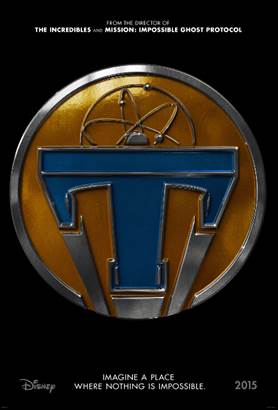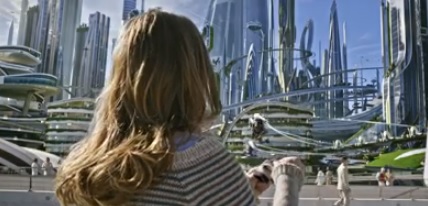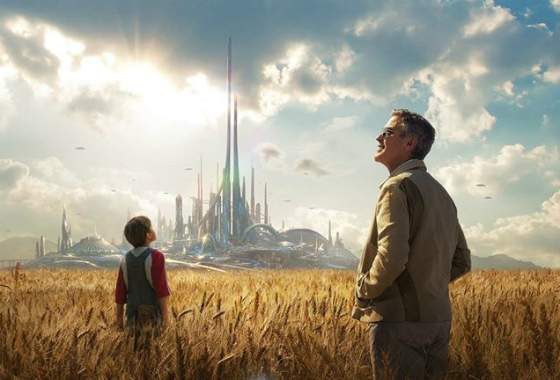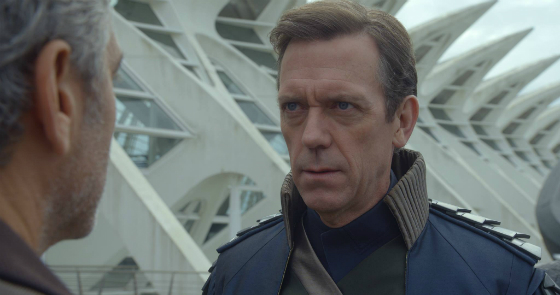TR Review: Tomorrowland Is a Messy, Fun Throwback
 |
There are obvious jokes to be made about the first movie to be adapted from an area within a theme park – post credits, you may wonder, is Tomorrowland recruited by Parking Lot and Nurse’s Station to join the Magic Kingdom Defenders? (Oh snap; I just remembered Jon Favreau is doing a Magic Kingdom movie, isn’t he?) Fortunately, you may wonder in the best sense – if there’s one thing Brad Bird’s new movie is filled with, it’s the w-word.
It may even have too much of it for its own good: like a cinematic Chipotle quesarito, it’s stuffed with more than enough for one meal, and made unnecessarily complicated to compensate. Yet it still manages to capture some of the magic of older Disney live-action adventures, which were frequently sloppy even back in the day.
Bird’s obsessions are all on full display in a way any fan of his previous films (The Iron Giant, The Incredibles, etc.) will recognize: we have giant robots, conveyer belts leading to secret elevators leading to secret lairs like massive and improbably theme park rides, technology being misappropriated, themes of specialness and power versus separation, and apocalyptic doomsday weapons. They’re less integrated and more like a drinking game than before, but it’s becoming clearer than ever that his body of work as a whole is all of a piece. It is perhaps the collaboration with Damon Lindelof that confuses the issue – what actually amounts in the end to a straightforward story is adapted into a Mystery Box structure via deliberately nonlinear telling. Fortunately, the box does not prove empty in the end – “emotionally distancing” would be a more accurate description.
 |
Going in spoiler-free may be advisable – curiously, most of the trailers you’ve seen so far primarily feature footage from the midpoint of the movie, and not the beginning as you may have suspected. This is due to the narrative rejiggering – we open on George Clooney’s Frank and Britt Robertson’s Casey directly addressing the camera while appearing to be on board some kind of spaceship. From there, we hear first Frank’s origin story and then – right as it gets to a point that would actually explain the plot – have Casey interrupt to tell us her backstory. Once that’s done, and we’re an hour into the movie, we can actually find out how they met in the first place.
 |
The story begins at the 1964 world’s fair, at which Disneyland’s It’s a Small World ride debuted. Young Frank (Thomas Robinson) has entered an inventing competition there with a homemade jetpack. While he is initially rejected because the device doesn’t work as it should, a mysterious English-accented girl named Athena (Raffey Cassidy) slips him a mysterious pin which, when scanned by a before-its-time laser inside It’s a Small World, opens the ride into an entirely different area (allowing Disney to completely reimagine the actual Small World in the future as a tie-in, should they choose to do so). A boat leads to an elevator, which leads to skyways, which leads to a full-on city of the future in an alternate dimension…but before we can learn too much, the film resets, and we start anew at the beginning of Casey’s tale.
It’s best not to reveal too much of what happens next, because we don’t have all day, and there’s a lot of plot. The often-contradictory themes are more interesting – Tomorrowland wants to have it both ways as regards its eponymous region (and by extension, Disney itself), portraying Tomorrowland both as a utopia that makes people dream, AND a cynical betrayal/undermining of same, such that Disney haters and lovers can find things in there to support their point of view. It is at once a liberal call to science and environmentalism, AND an Ayn Rand-like libertarian call to “go Galt” and solve problems in a separate country free from government interference and pesky safety regulations. It wants to chastise us for liking apocalypse-themed entertainment – awkward timing the week after everyone has fallen for Mad Max: Fury Road – AND threaten us with an uber-apocalypse that combines global jihadism, climate change and nuclear war all at once. Along the way, we get tonally incongruent bits like Keegan-Michael Key and Kathryn Hahn hamming it up as owners of a collectible toy and memorabilia store, and a ton of Disney easter eggs (I noticed one clever visual nod to the Twilight Zone Tower of Terror ride, and suspect there are many I missed).
 |
| House of the Future! |
Visually, Bird sometimes feels adrift in the greenscreen. Perhaps because he’s used to being an animator, he misses those couple of extra steps that would integrate the live elements fully, and make a kid with a fan blowing in his face actually look like he’s really jetpacking across a sci-fi skyscape. If you couldn’t get past that kind of thing in the Star Wars prequels, you’ll definitely have issues here. That said, older Disney movies have similar problems with bluescreen compositions (seen The Rocketeer lately?) and we tend to forgive them if the movie is good. And Tomorrowland, despite the nits I’m picking at, is mostly good – Robertson gives a solid breakthrough performance as heroine Casey, and Cassidy, despite a sometimes-shaky English accent, makes her potentially creepy ageless child a fully developed person.
That Bird, who probably made most of you cry with The Iron Giant, fails to elicit tears at a pivotal moment is mystifying – I admit that some of the emotional stuff in Interstellar managed to get to me in spite of myself, but when George Clooney finally cried here, I felt nothing. It may be that because Frank takes a backseat to Casey as a character, his arc just isn’t as resonant when we have to guess at a lot of it, or it may be that there’s too much plot happening to take a breather. The movie’s sense of fun, though, won me over in the end, and ultimately being Brad Bird’s least-best film is still pretty good – as throwbacks go, it seals the deal a whole lot better than JJ Abrams’ Super 8 while being refreshingly complete for a potential franchise. The ending certainly sets up directions that sequels could go, but the story at hand is done. Like its onscreen fictional city, the real test will be to see if this movie inspires kids of today to tell even more stories…tomorrow.
